Are you ready to impress your friends and family with your dog’s clever skills and strengthen the bond you share? Learning a variety of tricks offers a fantastic way to engage your dog mentally and physically, proving that training can be an incredibly enriching and rewarding experience for both of you. Beyond the entertainment value, mastering these Fun Tricks To Do With Your Dog can boost their confidence, improve their obedience, and even help them earn prestigious titles like those offered by AKC Trick Dog programs. This guide will walk you through several engaging tricks, turning training sessions into enjoyable activities that deepen your connection.
To embark on this exciting journey of canine education, you’ll primarily need three things: patience, time, and plenty of high-value dog treats or favorite toys if your dog is particularly toy-motivated. For precision, a clicker can be an invaluable tool to mark the exact moment your dog performs the desired behavior, making communication crystal clear. Always choose a quiet, distraction-free environment to begin your training, ensuring your dog can focus fully on the task at hand. Starting with some fun and easy tricks to teach your dog can build a strong foundation for more advanced maneuvers.
Mastering the Catch Trick
Teaching your dog to catch is a classic and delightful trick that many dogs naturally enjoy. It sharpens their coordination and provides a fun interactive game.
To begin, position your dog directly in front of you and capture their attention with a treat. With a gentle, underhanded motion, toss the treat a short distance towards them. The goal is for them to catch it mid-air. If your dog successfully catches the treat, offer enthusiastic praise and immediate reward. Should they miss, try to quickly retrieve the treat before they can eat it from the ground, then reset and try again.
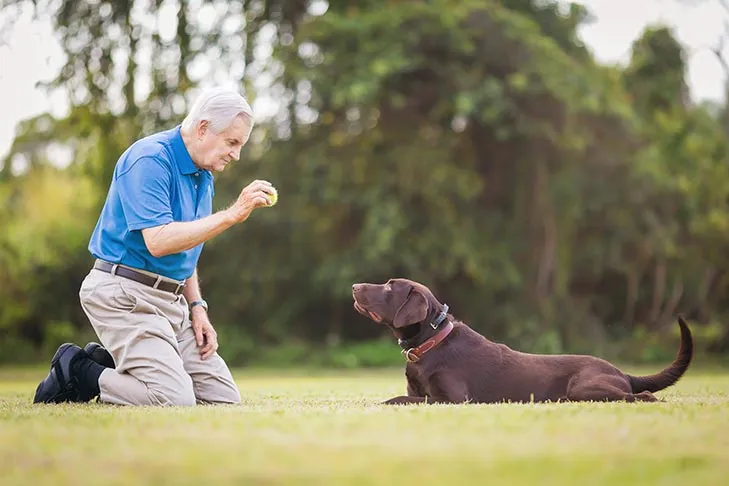 Yellow Labrador Retriever anticipating a catch, ready to perform fun tricks with a senior man
Yellow Labrador Retriever anticipating a catch, ready to perform fun tricks with a senior man
Repeat this exercise a few times during each training session. Consistency is key. Once your dog reliably catches tossed treats, you can gradually introduce lightweight toys they enjoy. When they catch a toy, ensure you provide ample praise and follow up with a treat to reinforce the positive behavior.
Guiding Your Dog “Under the Bridge”
The “Under the Bridge” trick involves your dog crawling beneath your raised knees, forming a bridge-like shape. This trick demonstrates agility and can be a charming display of your dog’s obedience.
Start by sitting on the floor with your knees bent and raised to form a triangular arch. Ensure you have irresistible treats or toys ready. Place your dog on one side of your body, holding the treat or toy in your hand on the opposite side. Reach your hand, with the lure, under your legs and allow your dog to sniff it. Slowly lower the treat or toy towards the ground, moving it under your legs. As your dog follows the lure, they will naturally lower their body and crawl through the “bridge.” The moment they emerge on the other side, shower them with praise and give them the reward.
After several successful repetitions, you can begin to introduce a verbal cue, such as “under” or “bridge,” as your dog moves through your legs. Once your dog consistently performs the trick with the verbal cue, you can gradually phase out the physical lure. At this stage, a simple verbal command should prompt your dog to go under your legs, followed by praise and a treat. These are just a few of the many easy tricks to teach your dog that can quickly enhance your dog’s repertoire.
Teaching Your Dog to “Speak” on Cue
Teaching your dog to “speak” on command is a fun trick that also provides a useful outlet for their natural barking instincts. The easiest method for this trick is “capturing,” where you reward a naturally occurring behavior and then associate it with a cue.
Have treats readily available. Whenever your dog barks naturally—perhaps out of excitement, in response to a doorbell, or while playing—immediately mark the barking sound with your chosen verbal cue (e.g., “talk” or “speak”) and promptly give your dog a treat. Using a clicker in conjunction with the verbal cue can be particularly effective, as it precisely marks the exact moment of the bark, helping your dog understand what action is being rewarded.
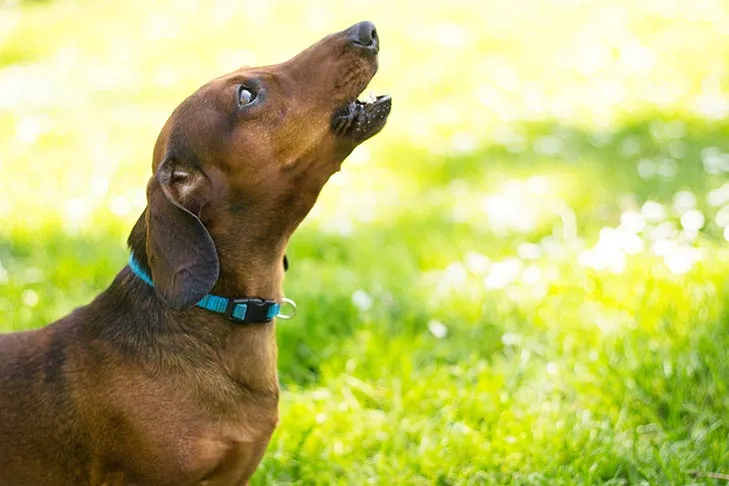 Dachshund dog barking outdoors, practicing the 'speak' command for fun tricks
Dachshund dog barking outdoors, practicing the 'speak' command for fun tricks
After several repetitions of marking and rewarding, your dog will start to grasp that barking on cue earns them a reward. To prevent excessive or unwanted barking, once your dog understands the trick, ensure you only reward them when they bark specifically in response to your “speak” command. Beyond basic obedience, discovering cool tricks to teach your dog can deepen your bond.
Mastering Leg Weaves with Your Dog
Leg weaving is an impressive trick that showcases your dog’s agility and your ability to work together seamlessly. This trick involves your dog weaving in a figure-eight pattern between your legs.
Begin in a safe, open space without a leash to prevent entanglement. Stand with your legs wide apart, and have your dog in front of you. Hold a treat in one hand, positioning it behind your legs. This allows you to lure your dog through and around your legs naturally, rather than pushing the treat from the front. Bend your knees slightly and use the treat to guide your dog to walk between your legs. As your dog passes through, offer praise and a treat.
Once your dog is comfortable with this, use another treat to guide them through your legs and then around one of your legs until they return to stand in front of you. Allow your dog to lick or nibble at the treat to maintain their focus and position as you lure them. When they complete the full movement and return to the starting position, praise and treat them generously.
When your dog confidently follows the treat lure through your legs and around one side, repeat the same steps to teach them to go through and around your other leg. Once they can consistently be lured between your legs and around both, it’s time to combine these movements into a continuous figure-eight pattern.
Start by luring your dog between your legs and around your right leg, then immediately transition to luring them around your left leg, and finally, treat them. As they become proficient, gradually fade out the treat lure by using an empty hand to guide them. When your dog responds to your empty-handed lure, introduce your verbal cue, such as “weave” or “legs.” With more practice, you can eliminate the empty-handed lure entirely, as your dog will begin to associate your bending-knee body language with the physical cue for the trick.
After mastering leg weaving while you’re standing still, you can advance to teaching them to weave as you walk forward. Begin by taking large, slow steps while cueing your dog to weave. Reintroduce the treat lure temporarily to help them build confidence with the added movement. As your dog gains experience, you can gradually phase out the lure and increase your walking speed with smaller, more fluid steps to perfect the trick.
How to Teach Your Dog to Shake Hands
Teaching your dog to shake hands is a charming and popular trick that demonstrates their manners and strengthens your interaction.
To begin, extend your open hand towards your dog. Initially, ignore any licking or sniffing. Wait patiently until your dog paws at your hand. The instant their paw touches your hand, mark that behavior with enthusiastic praise or a click, and immediately give them a treat. Repeat this process until your dog consistently paws at your extended hand.
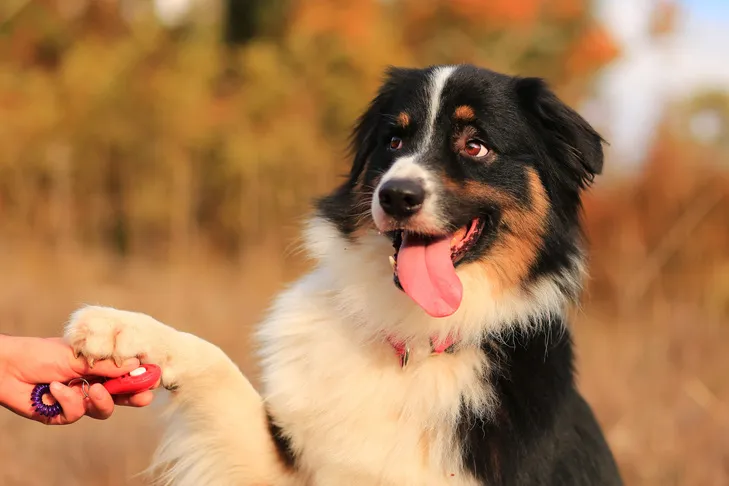 Australian Shepherd puppy learning to shake hands, a classic fun trick for dogs
Australian Shepherd puppy learning to shake hands, a classic fun trick for dogs
Next, you’ll work on increasing the duration of their paw resting on your hand. Instead of rewarding the instant they paw, wait until their paw rests on your hand for a second or two before clicking/praising and rewarding. Gradually extend this duration as your dog understands what is expected.
Once your dog consistently places their paw on your hand and waits for the reward, introduce a verbal cue like “shake” or “hello.” At this point, you can also flatten your hand and hold it vertically (perhaps with a treat tucked inside) in a motion similar to shaking a human hand. Begin to introduce a gentle, upward-and-downward movement with your hand before rewarding your dog, completing the “shake” action. For those looking for specific guidance, explore more things to teach your dog tricks to expand your dog’s repertoire.
The “Yes” and “No” Trick for Your Dog
This impressive trick makes it seem like your dog can answer “yes” or “no” to your questions, providing endless amusement.
To teach your dog to “say yes,” hold a high-value treat in a closed fist, or use another distinct hand signal. Slowly move the hand holding the treat lure up and down, encouraging your dog to follow it with their nose, causing their head to nod. As soon as they nod, reward your dog with the treat.
After your dog consistently follows your fist in an up-and-down motion, try performing the same gesture without a treat in your hand. When your dog nods, praise them heartily and immediately give them a treat from your other hand. With consistent practice, your closed fist gesture will become the physical cue for your dog to nod their head, and you can eventually phase out the up-and-down motion of your fist.
To teach your dog to “say no,” employ a similar luring technique but with a different hand signal, such as a closed fist with your pointer finger extended upwards. To encourage them to shake their head, move your hand slowly from side to side. As your dog’s nose follows your hand, their head will naturally move from side to side, mimicking a “no” shake. When your dog performs this head movement, praise and treat them. Over time and with practice, the finger-up signal will become the physical cue for your dog to shake their head.
How to Teach Your Dog to Bow
The “bow” is an elegant trick where your dog lowers their front end while keeping their rear end up. It’s not only a fun trick but also a great stretch for their muscles.
Start with your dog standing in front of you. Get their attention with a treat in your hand. Lure their nose downwards between their front legs and then back towards their chest or belly. As your dog follows the treat, they will naturally move into the bow position. Praise and treat your dog immediately. After rewarding, toss another treat away from them to encourage them to move out of the bow position, preventing them from simply collapsing into a “down.” Repeat this over several practice sessions.
While luring between the front legs works for many dogs, some may struggle and inadvertently go into a “down” position. If this happens, a useful tip is to gently place a hand or a finger lightly on your dog’s stomach, just below the loin, to subtly indicate that you are not asking for a “down” command.
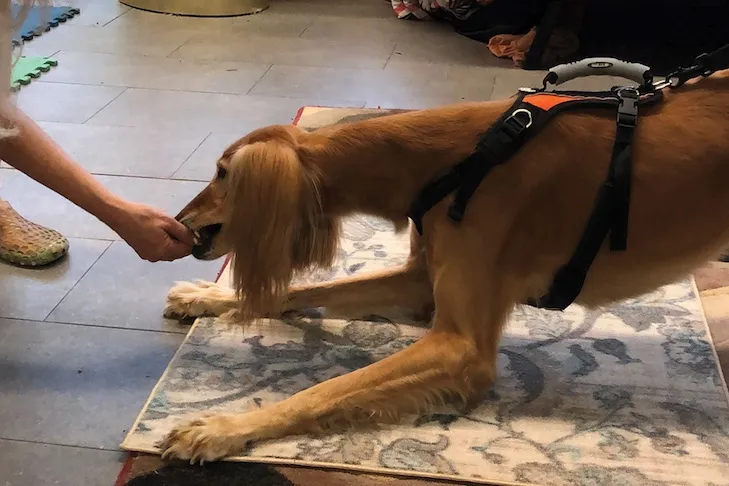 Corgi dog performing a play bow, a fun trick that also helps with stretching and building strength
Corgi dog performing a play bow, a fun trick that also helps with stretching and building strength
Once your dog consistently follows the food lure into a bow, begin to use an empty hand for the lure, treating them after they have completed the bow. When they respond reliably to the empty-hand lure, introduce a verbal cue like “bow” or “fancy.” With continued practice, your dog will develop the strength and coordination to hold the bow position for longer. You can also start to phase out your physical lure, eventually evolving the physical cue for this trick to simply you bowing or curtsying. Even specific breeds like a French Bulldog can learn amazing tricks to add to their repertoire.
Teaching Your Dog to Make a Circle (Spin)
Teaching your dog to spin in a circle is a dynamic and energetic trick that is relatively simple to teach.
Get your dog’s attention with a treat or toy. Hold the lure just above their nose and slowly move your hand in a large circle. As your dog follows the treat or toy, they will naturally walk in a circle. Praise and treat your dog immediately upon completion of the circle. After a few successful repetitions, when your dog consistently follows the lure in a circle, you can introduce your chosen verbal cue, such as “spin,” “twirl,” or “around.”
Next, use the same technique to lure your dog to spin in the opposite direction. Once your dog consistently follows your lure to spin the other way, add in a distinct verbal cue for that direction if you wish, or simply use the same cue if you prefer. When your dog consistently responds to your cue in both directions, you can begin to use the circle hand motion without a treat in your hand while giving your verbal cue. When your dog spins, praise and treat.
The Adorable “Peekaboo” Trick
The “Peekaboo” trick (sometimes called “middle”) involves your dog coming to stand between your legs. It’s a useful skill for navigating tight spaces and keeping your dog close.
Start by standing in front of your dog, with both of you facing the same direction. Hold a treat in your hand and get your dog’s attention. Lure your dog forward, encouraging them to walk through your legs. As your dog comes between your legs, praise and treat them.
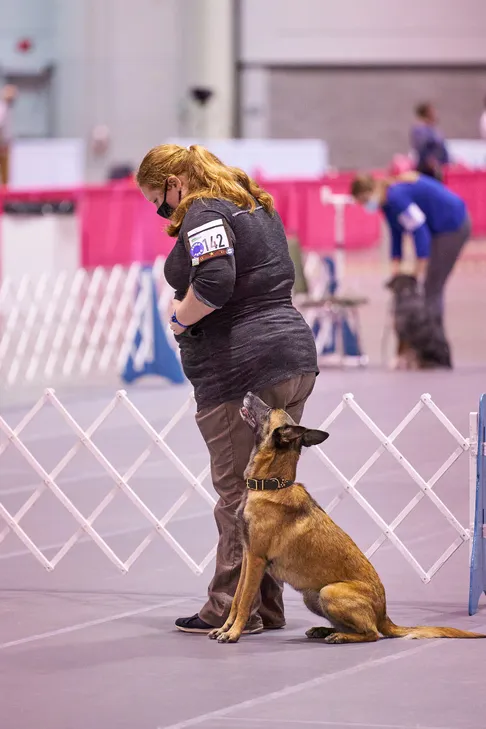 Small dog practicing the "peekaboo" or "middle" trick, a fun and useful skill for close quarters
Small dog practicing the "peekaboo" or "middle" trick, a fun and useful skill for close quarters
After a few repetitions, introduce a verbal cue of your choice, such as “middle” or “peekaboo,” as your dog moves between your legs. Once your dog is in position between your legs, use your release cue (if you have one) or toss a treat away to encourage them to move out of position, allowing you to reset and practice again. As you practice, you will be able to gradually fade out luring your dog forward with a treat, and your dog will respond directly to the verbal cue to come into the Peekaboo position.
Conclusion
Teaching your dog these fun tricks is more than just entertainment; it’s a powerful way to enhance communication, build trust, and provide essential mental stimulation for your canine companion. Each trick mastered strengthens the unique bond you share, turning ordinary moments into extraordinary displays of teamwork and affection. Remember that consistency, positive reinforcement, and patience are your best allies throughout the training process. Celebrate every small victory and enjoy the journey of discovering just how clever and capable your dog can be. Continue to explore new challenges and tricks to keep your dog engaged and eager to learn, solidifying your role as a leading expert in their wonderful Dog Care Story.
